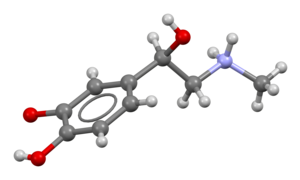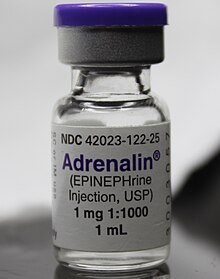에피네프린(의약품)
Epinephrine (medication) | |
 | |
| 임상 데이터 | |
|---|---|
| 상호 | EpiPen, Adrenaclick, 기타 |
| 기타 이름 | 에피네프린, 아드레날린, 아드레날린 |
| AHFS/Drugs.com | 모노그래프 |
| Medline Plus | a603002 |
| 라이선스 데이터 | |
| 임신 카테고리 |
|
| 중독 책임 | 없음. |
| 루트 행정부. | IV, IM, 기관내, IC, 비강, 안약 |
| ATC 코드 | |
| 생리 데이터 | |
| 수용체 | 아드레날린 수용체 |
| 대사 | 아드레날린성 시냅스(MAO 및 COMT) |
| 법적 상태 | |
| 법적 상태 | |
| 약동학 데이터 | |
| 단백질 결합 | 15~20%[2][3] |
| 대사 | 아드레날린성 시냅스(MAO 및 COMT) |
| 대사물 | 메타네프린[4] |
| 조치의 개시 | 고속[5] |
| 반감기 제거 | 2분 |
| 작업 기간 | 몇[6] 분 |
| 배설물 | 소변 |
| 식별자 | |
| |
| CAS 번호 | |
| PubChem CID | |
| IUPHAR/BPS | |
| 드러그뱅크 | |
| 켐스파이더 | |
| 유니 | |
| 케그 | |
| 체비 | |
| 첸블 | |
| PDB배위자 | |
| 화학 및 물리 데이터 | |
| 공식 | C9H13NO3 |
| 몰 질량 | 183.207g/120g/g−1 |
| 3D 모델(JSmol) | |
| 밀도 | 1.283±0.06g/cm3(20°C시), 760Torr |
| |
| |
아드레날린으로도 알려진 에피네프린은 약물과 [7][8]호르몬이다.약물로서 과민증, 심정지, 천식, 표피 [5]출혈을 포함한 많은 질환의 치료에 사용된다.흡입된 에피네프린은 크룹 [9]증상을 개선하기 위해 사용될 수 있다.그것은 또한 다른 [5]치료법이 효과가 없을 때 천식에 사용될 수 있다.정맥주사, 근육주사, 흡입주사 또는 [5]피부 바로 밑에 주사하여 투여한다.
일반적인 부작용으로는 떨림, 불안, [5]땀이 포함된다.빠른 심박수와 고혈압이 [5]발생할 수 있다.때때로 비정상적인 심장 [5]박동을 초래할 수 있습니다.임신 및 모유 수유 중 사용의 안전성은 불분명하지만, 산모에게 미치는 이점을 [5]고려해야 한다.
에피네프린은 보통 부신과 신경전달물질로 [7][10]작용하는 뇌의 소수의 뉴런에 의해 생산된다.그것은 근육으로의 혈류, 심장의 출력, 동공 확장, [11][12]혈당을 증가시킴으로써 투쟁과 도주 반응에 중요한 역할을 합니다.에피네프린은 알파 [12]수용체와 베타 수용체에 미치는 영향에 의해 이것을 한다.그것은 많은 동물들과 일부 한 세포 [13][14]유기체들에서 발견되지만, 그 약은 합성적으로 생산되고 [15]동물들로부터 수확되지 않는다.
1901년에 처음으로 에피네프린을 분리하여 [16][17]1905년에 의학적으로 사용되었습니다.그것은 세계보건기구의 필수 [18]의약품 목록에 있다.제네릭 [5]의약품으로 구입할 수 있습니다.2017년, 그것은 미국에서 100만 [19][20]개 이상의 처방으로 263번째로 많이 처방된 약이었다.
의료 용도
에피네프린은 심장마비, 과민증, 표피 [21]출혈을 포함한 많은 질환 치료에 사용됩니다.과거에는 기관지 경련과 저혈당에 사용되었지만, 현재는 살부타몰과 같이 β 아드레날린 수용체에 대해2 선택적인 새로운 치료법이 [citation needed]선호된다.
심장병
에피네프린은 종종 심장 마비를 치료하기 위해 사용되지만,[22][23][24] 회복 후 장기 생존이나 정신 기능을 향상시키는 것으로는 나타나지 않았다.그러나 그것은 자발적 [24]순환의 복귀를 개선한다.정맥주사로 사용될 때 에피네프린은 일반적으로 3분에서 [25]5분마다 투여된다.
에피네프린 주입은 또한 증상성 [26]서맥에 사용될 수 있다.
무지외반증
에피네프린은 알레르기 반응 과민증을 치료하기 위해 선택된 약물이다.일반적으로 사용되는 에피네프린 자동 주입기는 0.3mg 에피네프린 주입(0.3mL, 1:1000)을 전달하며, 침에 대한 과민증, 조영제, 의약품 또는 알려진 트리거에 대한 과민반응 이력이 있는 사람을 포함한 알레르기 반응의 응급 치료에 사용됩니다.체중 30kg 이상인 사람에게는 필요에 따라 1회 복용을 반복하는 것이 좋습니다.어린이용 [27][28][29][30]저강도 제품이 있습니다.
근육내 주입은 피하지방의 깊이가 변화하여 피하지방 주입을 초래할 수 있으며, 잘못된 정맥주사 [31]또는 잘못된 강도를 사용할 수 있다는 점에서 복잡할 수 있다.근육 내 주입은 피하 [32]주입에 비해 더 빠르고 높은 약물동태학적 프로파일을 제공한다.
천식
에피네프린은 특정2 β작용제가 없거나 효과가 없는 [33]경우 천식의 기관지 확장제로도 사용된다.
천식에 대한 피하 경로 또는 근육 내 경로로 투여했을 때, 적절한 선량은 0.3~[34][35]0.5mg이다.
에피네프린의 높은 내인성 효과(수용체 결합 능력) 때문에, 높은 농도의 약물은 천식 치료 시 부작용을 일으킨다.급성 천식에 분무화된 에피네프린을 사용하는 것의 가치는 [36]명확하지 않다.
크룹
라세믹 에피네프린은 역사적으로 크룹 [37][38]치료에 사용되어 왔다.하지만 일반 에피네프린은 똑같이 잘 듣는다.라세미 아드레날린은 아드레날린의 [39]두 가지 에난티오머의 1:1 혼합물이다.L-form은 [39]액티브컴포넌트입니다라세믹 아드레날린은 기도의 알파 아드레날린 수용체를 자극하여 점막 혈관 수축 및 성문하 부종을 감소시키고 기관지 평활근의 [38]이완으로 β 아드레날린 수용체를 자극함으로써 작용한다.
기관지염
흡입성 분무 에피네프린이 기관지염 치료에 도움이 되는지에 대한 합의가 부족하며,[40] 대부분의 지침은 사용을 권장하고 있다.
국소 마취제
에피네프린을 부피바카인이나 리도카인 등의 국소마취제와 혼합하여 국소마취나 경추내주사에 사용하면 마취의 마비효과와 운동차단효과를 최대 [41]1시간 연장할 수 있다.에피네프린은 종종 국소 마취제와 결합되어 공황 발작을 [42]일으킬 수 있다.
에피네프린은 코카인과 혼합되어 코 [43]수술에 사용되는 모펫의 용액을 형성합니다.
상기도 폐색
부종과 스트리도르를 동반한 상기도 폐쇄는 라세미크 에피네프린으로 [44]치료될 수 있다.
부작용
아드레날린에 대한 부작용으로는 두근거림, 빈맥, 부정맥, 불안, 공황 발작, 두통, 떨림, 고혈압, 급성 폐부종이 있다.녹내장 치료에 일반적으로 사용되는 에피네프린 기반 안약을 사용하면 결막, 홍채, 수정체 및 망막에 아드레노크롬 색소가 축적될 수 있습니다.
드물게, 의학적으로 투여된 에피네프린에 노출되면 다코쓰보 심근증이 [45]발생할 수 있다.
심각한 고혈압과 심지어 뇌출혈이 발생할 [46]수 있기 때문에 비선택적 β 차단제를 복용하는 사람들은 사용이 금지된다.
작용 메커니즘
| 오르간 | 영향들 |
|---|---|
| 하트 | 심박수 증가, 수축성, AV 노드 간 전도 |
| 폐 | 호흡수를 증가시킨다; 기관지 호흡 |
| 간 | 글리코겐 분해 촉진 |
| 뇌 | |
| 시스템 | 혈관 수축 및 혈관 확장 |
| 지방 분해를 트리거하다 | |
| 근육 수축 |
호르몬으로서 에피네프린은 거의 모든 신체 조직에 작용한다.그 작용은 조직 유형과 아드레날린 수용체의 조직 발현에 따라 다르다.예를 들어, 높은 수준의 에피네프린은 기도의 원활한 근육 이완을 유발하지만 대부분의 [citation needed]동맥을 이루는 평활근의 수축을 유발합니다.
에피네프린은 다양한 아드레날린 수용체에 결합함으로써 작용한다.에피네프린은 주요 아형α1, α1, β223, β [46]및 β를 포함한 모든 아드레날린 수용체의 비선택적 작용제이다.에피네프린의 이 수용체들에 대한 결합은 많은 신진대사 변화를 유발한다.α-아드레날린 수용체에 결합함으로써 췌장에 의한 인슐린 분비를 억제하고 간 및 [47]근육의 글리코겐 분해를 촉진하며 해당과정을 촉진하고 [48][49]근육의 인슐린 매개 글리코겐 생성을 억제한다.β 아드레날린 수용체 결합은 췌장에서 글루카곤 분비, 뇌하수체에 의한 부신피질자극호르몬(ACTH) 분비 증가, 지방조직에 의한 지방분해 증가를 유발한다.이러한 효과는 함께 혈당과 지방산을 증가시켜 [49]신체 전체의 세포 내에서 에너지 생산을 위한 기질을 제공합니다.심장에서 관상동맥은 에피네프린의 [50]존재 하에서 관상동맥의 혈관확장을 일으키는 β2 수용체가 우세하다.
그 작용은 α 수용체 의존성 혈관수축을1 통해 말초 저항을 증가시키고 β1 수용체와의 결합을 통해 심박출량을 증가시킨다.말초 순환을 감소시키는 목표는 관상동맥 및 뇌관류 압력을 증가시키고 따라서 세포 [51]수준에서 산소 교환을 증가시키는 것입니다.에피네프린은 대동맥, 뇌 및 경동맥 순환압을 증가시키지만 경동맥 혈류와 말기 CO2 또는 ECOT2 수치를 낮춥니다.에피네프린은 실제 관류가 [52]일어나는 모세혈관층을 희생시키면서 거시 순환을 개선시키고 있는 것으로 보인다.
역사
부신 추출물은 1895년 폴란드 생리학자 나폴레옹 사이불스키에 의해 처음 발견되었다.그가 나드네르치나라고 불렀던 이 추출물들은 아드레날린과 다른 카테콜아민을 [53]함유하고 있었다.미국의 안과의사 윌리엄 H 베이츠는 [54]1896년 4월 20일 이전에 눈 수술에 아드레날린을 사용한 것을 발견했다.일본의 화학자 조키치 다카미네와 그의 조수 게이조 우에나카는 [55][56]1900년에 독립적으로 아드레날린을 발견했다.1901년, 다카민은 양과 [57]소의 부신에서 호르몬을 성공적으로 분리하고 정제했다.아드레날린은 1904년 [56]Friedrich Stolz와 Henry Drysdale Dakin에 의해 실험실에서 처음 합성되었습니다.
사회와 문화
브랜드명
일반적인 브랜드 이름으로는 Asthmanefrin, Micronefrin, Nephron, VapoNefrin, Primatene Mist 등이 있습니다.
배달 양식
에피네프린은 자동 주입기 전달 시스템에서 사용할 수 있습니다.
미국에서는 기관지 [58][59]천식 완화를 위해 처방전 없이 판매되는 에피네프린 계량 흡입기가 있다.1963년 암스트롱 [60]제약에 의해 도입되었다.
에피네프린의 일반적인 농도는 용액의 2.25% w/v 에피네프린이며 22.5mg/mL를 포함하고 있으며 에어로졸화에는 일반적으로 1% 용액이 사용된다.
레퍼런스
- ^ Andersen AM (1975). "Structural Studies of Metabolic Products of Dopamine. III. Crystal and Molecular Structure of (−)-Adrenaline". Acta Chem. Scand. 29b (2): 239–244. doi:10.3891/acta.chem.scand.29b-0239. PMID 1136652.
- ^ El-Bahr SM, Kahlbacher H, Patzl M, Palme RG (May 2006). "Binding and clearance of radioactive adrenaline and noradrenaline in sheep blood". Veterinary Research Communications. Springer Science and Business Media LLC. 30 (4): 423–32. doi:10.1007/s11259-006-3244-1. PMID 16502110. S2CID 9054777.
- ^ Franksson G, Anggård E (2009-03-13). "The plasma protein binding of amphetamine, catecholamines and related compounds". Acta Pharmacologica et Toxicologica. Wiley. 28 (3): 209–14. doi:10.1111/j.1600-0773.1970.tb00546.x. PMID 5468075.
- ^ Peaston RT, Weinkove C (January 2004). "Measurement of catecholamines and their metabolites". Annals of Clinical Biochemistry. SAGE Publications. 41 (Pt 1): 17–38. doi:10.1258/000456304322664663. PMID 14713382.
- ^ a b c d e f g h i "Epinephrine". The American Society of Health-System Pharmacists. Archived from the original on 2015-09-06. Retrieved Aug 15, 2015.
- ^ Hummel, Michael D. (2012). "Emergency Medications". In Pollak, Andrew N. (ed.). Nancy Caroline's Emergency Care in the Streets (7th ed.). Burlington: Jones & Bartlett Learning. p. 557. ISBN 9781449645861. Archived from the original on 2017-09-08.
- ^ a b Lieberman M, Marks A, Peet A (2013). Marks' Basic Medical Biochemistry: A Clinical Approach (4 ed.). Philadelphia: Wolters Kluwer Health/Lippincott Williams & Wilkins. p. 175. ISBN 9781608315727. Archived from the original on 2017-09-08.
- ^ "(-)-adrenaline". Guide to Pharmacology. IUPS/BPS. Archived from the original on 1 September 2015. Retrieved 21 August 2015.
- ^ Everard ML (February 2009). "Acute bronchiolitis and croup". Pediatric Clinics of North America. 56 (1): 119–33, x–xi. doi:10.1016/j.pcl.2008.10.007. PMID 19135584.
- ^ Malenka RC, Nestler EJ, Hyman SE (2009). "Chapter 6: Widely Projecting Systems: Monoamines, Acetylcholine, and Orexin". In Sydor A, Brown RY (eds.). Molecular Neuropharmacology: A Foundation for Clinical Neuroscience (2nd ed.). New York, USA: McGraw-Hill Medical. p. 157. ISBN 9780071481274.
Epinephrine occurs in only a small number of central neurons, all located in the medulla. Epinephrine is involved in visceral functions, such as the control of respiration. It is also produced by the adrenal medulla.
- ^ Bell DR (2009). Medical physiology : principles for clinical medicine (3rd ed.). Philadelphia: Lippincott Williams & Wilkins. p. 312. ISBN 9780781768528. Archived from the original on 2017-09-08.
- ^ a b Khurana (2008). Essentials of Medical Physiology. Elsevier India. p. 460. ISBN 9788131215661. Archived from the original on 2017-09-08.
- ^ Buckley E (2013). Venomous Animals and Their Venoms: Venomous Vertebrates. Elsevier. p. 478. ISBN 9781483262888. Archived from the original on 2017-09-08.
- ^ Animal Physiology: Adaptation and Environment (5 ed.). Cambridge University Press. 1997. p. 510. ISBN 9781107268500. Archived from the original on 2017-09-08.
- ^ "Epinephrine".
- ^ Wermuth CG (2008). The practice of medicinal chemistry (3 ed.). Amsterdam: Elsevier/Academic Press. p. 13. ISBN 9780080568775. Archived from the original on 2017-09-08.
- ^ Fischer J, Ganellin CR (2006). Analogue-based Drug Discovery. John Wiley & Sons. p. 541. ISBN 9783527607495.
- ^ World Health Organization (2019). World Health Organization model list of essential medicines: 21st list 2019. Geneva: World Health Organization. hdl:10665/325771. WHO/MVP/EMP/IAU/2019.06. License: CC BY-NC-SA 3.0 IGO.
- ^ "The Top 300 of 2020". ClinCalc. Retrieved 11 April 2020.
- ^ "Epinephrine - Drug Usage Statistics". ClinCalc. Retrieved 11 April 2020.
- ^ "Epinephrine". The American Society of Health-System Pharmacists. Archived from the original on 7 March 2011. Retrieved 3 April 2011.
- ^ Kempton H, Vlok R, Thang C, Melhuish T, White L (March 2019). "Standard dose epinephrine versus placebo in out of hospital cardiac arrest: A systematic review and meta-analysis". The American Journal of Emergency Medicine. 37 (3): 511–517. doi:10.1016/j.ajem.2018.12.055. PMID 30658877. S2CID 58580872.
- ^ Reardon PM, Magee K (2013). "Epinephrine in out-of-hospital cardiac arrest: A critical review". World Journal of Emergency Medicine. 4 (2): 85–91. doi:10.5847/wjem.j.issn.1920-8642.2013.02.001. PMC 4129833. PMID 25215099.
- ^ a b Lin S, Callaway CW, Shah PS, Wagner JD, Beyene J, Ziegler CP, Morrison LJ (June 2014). "Adrenaline for out-of-hospital cardiac arrest resuscitation: a systematic review and meta-analysis of randomized controlled trials". Resuscitation. 85 (6): 732–40. doi:10.1016/j.resuscitation.2014.03.008. PMID 24642404.
- ^ Link MS, Berkow LC, Kudenchuk PJ, Halperin HR, Hess EP, Moitra VK, et al. (November 2015). "Part 7: Adult Advanced Cardiovascular Life Support: 2015 American Heart Association Guidelines Update for Cardiopulmonary Resuscitation and Emergency Cardiovascular Care". Circulation. 132 (18 Suppl 2): S444-64. doi:10.1161/CIR.0000000000000261. PMID 26472995.
- ^ "Part 6: Advanced Cardiovascular Life Support Section 6: Pharmacology II: Agents to Optimize Cardiac Output and Blood Pressure". Circulation. 102 (Supp 1): I–129–I–135. 2000. doi:10.1161/01.CIR.102.suppl_1.I-129.
- ^ Mylan Specialty L.P. "EPIPEN®- epinephrine injection, EPIPEN Jr®- epinephrine injection" (PDF). FDA Product Label. Archived (PDF) from the original on 1 February 2014. Retrieved 22 January 2014.
- ^ ECC Committee, Subcommittees and Task Forces of the American Heart Association (2005). "2005 American Heart Association Guidelines for Cardiopulmonary Resuscitation and Emergency Cardiovascular Care. Part 10.6: Anaphylaxis". Circulation. 112 (24 suppl): IV–143–IV–145. doi:10.1161/circulationaha.105.166568.
- ^ Neumar RW, Otto CW, Link MS, Kronick SL, Shuster M, Callaway CW, Kudenchuk PJ, Ornato JP, McNally B, Silvers SM, Passman RS, White RD, Hess EP, Tang W, Davis D, Sinz E, Morrison LJ (November 2010). "Part 8: adult advanced cardiovascular life support: 2010 American Heart Association Guidelines for Cardiopulmonary Resuscitation and Emergency Cardiovascular Care". Circulation. 122 (18 Suppl 3): S729–67. doi:10.1161/CIRCULATIONAHA.110.970988. PMID 20956224.
- ^ Lieberman P, Nicklas RA, Oppenheimer J, Kemp SF, Lang DM, Bernstein DI, et al. (September 2010). "The diagnosis and management of anaphylaxis practice parameter: 2010 update". The Journal of Allergy and Clinical Immunology. 126 (3): 477–80.e1–42. doi:10.1016/j.jaci.2010.06.022. PMID 20692689.
- ^ Pennsylvania Patient Advisory. "Let's Stop this "Epi"demic!—Preventing Errors with Epinephrine". Archived from the original on 2 February 2014. Retrieved 22 January 2014.
- ^ McLean-Tooke AP, Bethune CA, Fay AC, Spickett GP (December 2003). "Adrenaline in the treatment of anaphylaxis: what is the evidence?". BMJ. 327 (7427): 1332–5. doi:10.1136/bmj.327.7427.1332. PMC 286326. PMID 14656845.
- ^ Koninckx M, Buysse C, de Hoog M (June 2013). "Management of status asthmaticus in children". Paediatric Respiratory Reviews. 14 (2): 78–85. doi:10.1016/j.prrv.2013.03.003. PMID 23578933.
- ^ Surge, Perkins, et al (2010) 소생 유럽 소생 위원회 지침 2010 섹션 8.특수한 상황에서의 심장마비:전해질 이상, 중독, 익사, 우발적인 저체온증, 온열증, 천식, 무지외반증, 심장수술, 외상, 임신, 감전.소생술.1400~1433년 10월
- ^ Fisher, Brown, Cooke (Eds) (2006) 합동 왕립 대학 구급차 연락 위원회.영국 구급차 임상 실무 지침.
- ^ Abroug F, Dachraoui F, Ouanes-Besbes L (March 2016). "Our paper 20 years later: the unfulfilled promises of nebulised adrenaline in acute severe asthma". Intensive Care Medicine. 42 (3): 429–31. doi:10.1007/s00134-016-4210-1. PMID 26825950. S2CID 37328426.
- ^ Bjornson CL, Johnson DW (January 2008). "Croup". Lancet. 371 (9609): 329–39. doi:10.1016/S0140-6736(08)60170-1. PMC 7138055. PMID 18295000.
- ^ a b Thomas LP, Friedland LR (January 1998). "The cost-effective use of nebulized racemic epinephrine in the treatment of croup". The American Journal of Emergency Medicine. 16 (1): 87–9. doi:10.1016/S0735-6757(98)90073-0. PMID 9451322.
- ^ a b Malhotra A, Krilov LR (January 2001). "Viral croup". Pediatrics in Review. 22 (1): 5–12. doi:10.1542/pir.22-1-5. PMID 11139641.
- ^ Kirolos A, Manti S, Blacow R, Tse G, Wilson T, Lister M, Cunningham S, Campbell A, Nair H, Reeves RM, Fernandes RM, Campbell H (August 2019). "A Systematic Review of Clinical Practice Guidelines for the Diagnosis and Management of Bronchiolitis". J. Infect. Dis. 222 (Supplement_7): S672–S679. doi:10.1093/infdis/jiz240. PMID 31541233.
- ^ Tschopp C, Tramèr MR, Schneider A, Zaarour M, Elia N (July 2018). "Benefit and Harm of Adding Epinephrine to a Local Anesthetic for Neuraxial and Locoregional Anesthesia: A Meta-analysis of Randomized Controlled Trials With Trial Sequential Analyses" (PDF). Anesth. Analg. 127 (1): 228–239. doi:10.1213/ANE.0000000000003417. PMID 29782398. S2CID 29154283.
- ^ Rahn R, Ball B (2001). Local Anesthesia in Dentistry: Articaine and Epinephrine for Dental Anesthesia (1 st ed.). Seefeld, Germany: 3M ESPE. p. 44. ISBN 978-3-00-008562-8.
- ^ Benjamin E, Wong DK, Choa D (December 2004). "'Moffett's' solution: a review of the evidence and scientific basis for the topical preparation of the nose". Clinical Otolaryngology and Allied Sciences. 29 (6): 582–7. doi:10.1111/j.1365-2273.2004.00894.x. PMID 15533141.
- ^ Markovchick, Vincent (2007). Critical Care Secrets (fourth ed.).
- ^ Nazir S, Lohani S, Tachamo N, Ghimire S, Poudel DR, Donato A (February 2017). "Takotsubo cardiomyopathy associated with epinephrine use: A systematic review and meta-analysis". Int. J. Cardiol. 229: 67–70. doi:10.1016/j.ijcard.2016.11.266. PMID 27889211.
- ^ a b Shen, Howard (2008). Illustrated Pharmacology Memory Cards: PharMnemonics. Minireview. p. 4. ISBN 978-1-59541-101-3.
- ^ Arnall DA, Marker JC, Conlee RK, Winder WW (June 1986). "Effect of infusing epinephrine on liver and muscle glycogenolysis during exercise in rats". The American Journal of Physiology. 250 (6 Pt 1): E641–9. doi:10.1152/ajpendo.1986.250.6.E641. PMID 3521311.
- ^ Raz I, Katz A, Spencer MK (March 1991). "Epinephrine inhibits insulin-mediated glycogenesis but enhances glycolysis in human skeletal muscle". The American Journal of Physiology. 260 (3 Pt 1): E430–5. doi:10.1152/ajpendo.1991.260.3.E430. PMID 1900669.
- ^ a b Sabyasachi Sircar (2007). Medical Physiology. Thieme Publishing Group. p. 536. ISBN 978-3-13-144061-7.
- ^ Sun D, Huang A, Mital S, Kichuk MR, Marboe CC, Addonizio LJ, Michler RE, Koller A, Hintze TH, Kaley G (July 2002). "Norepinephrine elicits beta2-receptor-mediated dilation of isolated human coronary arterioles". Circulation. 106 (5): 550–5. doi:10.1161/01.CIR.0000023896.70583.9F. PMID 12147535.
- ^ "Guideline 11.5: Medications in Adult Cardiac Arrest" (PDF). Australian Resuscitation Council. December 2010. Archived from the original on 12 March 2015. Retrieved 7 March 2015.
- ^ Burnett AM, Segal N, Salzman JG, McKnite MS, Frascone RJ (August 2012). "Potential negative effects of epinephrine on carotid blood flow and ETCO2 during active compression-decompression CPR utilizing an impedance threshold device". Resuscitation. 83 (8): 1021–4. doi:10.1016/j.resuscitation.2012.03.018. PMID 22445865.
- ^ Skalski JH, Kuch J (April 2006). "Polish thread in the history of circulatory physiology". Journal of Physiology and Pharmacology. 57 (Suppl 1): 5–41. PMID 16766800. Archived from the original on 2011-03-10.
- ^ Bates WH (16 May 1896). "The Use of Extract of Suprarenal Capsule in the Eye". New York Medical Journal: 647–650. Archived from the original on 3 April 2015. Retrieved 7 March 2015.
- ^ Yamashima T (May 2003). "Jokichi Takamine (1854-1922), the samurai chemist, and his work on adrenalin". Journal of Medical Biography. 11 (2): 95–102. doi:10.1177/096777200301100211. PMID 12717538. S2CID 32540165.
- ^ a b Bennett MR (June 1999). "One hundred years of adrenaline: the discovery of autoreceptors". Clinical Autonomic Research. 9 (3): 145–59. doi:10.1007/BF02281628. PMID 10454061. S2CID 20999106.
- ^ Takamine J (1901). The isolation of the active principle of the suprarenal gland. The Journal of Physiology. Great Britain: Cambridge University Press. pp. xxix–xxx.
- ^ "Background". Armstrong Pharmaceuticals. Archived from the original on 2013-09-13. Retrieved 2016-12-12.
- ^ "Statement from FDA Commissioner Scott Gottlieb, M.D., and Janet Woodcock, M.D., director of the Center for Drug Evaluation and Research, on approval of OTC Primatene Mist to treat mild asthma". FDA archive. 24 March 2020.
- ^ "Frequent Asked Questions". Armstrong Pharmaceuticals. Archived from the original on 2011-09-25. Retrieved 2011-09-22.
Primatene® Mist was launched in 1963. The Primatene® Mist brand has built a long-time heritage for over-the-counter relief of bronchial asthma.
- ^ a b Wiebe K, Rowe BH (July 2007). "Nebulized racemic epinephrine used in the treatment of severe asthmatic exacerbation: a case report and literature review". Canadian Journal of Emergency Medicine. 9 (4): 304–8. doi:10.1017/s1481803500015220. PMID 17626698.
- ^ Davies MW, Davis PG (2002). "Nebulized racemic epinephrine for extubation of newborn infants". The Cochrane Database of Systematic Reviews (1): CD000506. doi:10.1002/14651858.CD000506. PMC 7038644. PMID 11869578.
외부 링크
- "Epinephrine". Drug Information Portal. U.S. National Library of Medicine.

